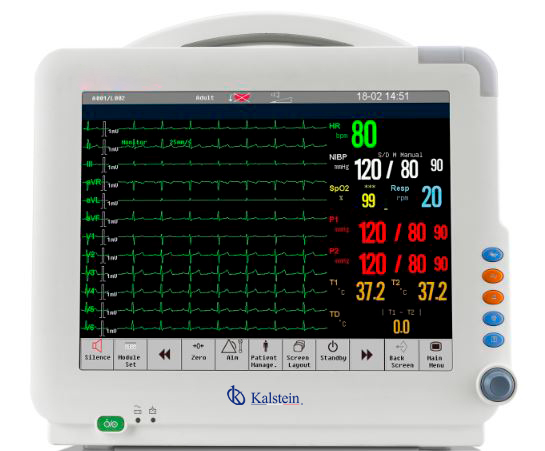A pediatric vital signs monitor, also known as a child monitor, is an electronic piece of equipment that continuously detects, processes and deploys the vital signs of the pediatric patient, such as: respiration rate, blood pressure, body temperature and pulse.
Vital signs refer to the outward manifestation of basic vital functions such as breathing, circulation and metabolism. Their variations express changes occurring in the body, some of physiological origin and others of pathological origin.
How does a pediatric vital signs monitor work?
A pediatric vital signs monitor works differently for each vital sign: in the case of heart rate, it amplifies the heart’s electrical potentials; in the case of respiratory rate, it magnifies the thorax’s breathing movements; and blood pressure and oxygen saturation will depend on the intensity of the pulse.
All these vital signs are then displayed separately on the vital signs monitor. The device is equipped with an alarm system that alerts medical staff when there is a negative situation, or when any of these vital signs are outside the desired limits for each pediatric patient.
What are the basic vital signs determined by this type of monitor?
- Respiratory rate: refers to the number of times a child breathes per minute. It is usually measured at rest and varies with age, and is the first vital sign to be assessed, since anxiety and agitation alter respiratory rate. In clinical situations that increase the child’s metabolic needs, such as pain and fever, respiratory rate is higher than normal.
- Heart rate is defined as the number of heartbeats per unit of time. A series of electrodes is used on the child’s body to record and amplify the heart’s electrical impulses.
- Arterial pressure: pressure exerted by the blood against the walls of the arteries, resulting from the minute cardiac volume multiplied by the peripheral arteriolar resistance, the latter being determined by the tone and condition of the arterioles. One of the main characteristics of blood pressure in children is that it is a variable parameter, with a wide distribution of values, which increase progressively as the child grows.
- Temperature: body temperature is the numerical expression of the body’s heat quantity. This parameter expresses the balance between heat production in the body and heat loss.
- O2 saturation: non-invasive measure of the oxygen carried by hemoglobin inside blood vessels. Normal O2 saturation values range from 95 to 97%, with a variation range of 2%.
Advantages of the Pediatric Vital Signs Monitor
- Fully adapted to working with children.
- These are electronic devices that are easily configured, as they are easily connected to the patient, and have quick access to define basic functions, alarm limits and alarm types.
- They are easy-to-use devices: they have rapid access to parameters during monitoring, show arrhythmias and trends, and generally allow paper recording.
- They have easy-to-learn functions and operating modes.
- They have simple designs, allowing correct display of curves and numerical data.
What can we offer you at Kalstein?
Kalstein is a MANUFACTURER of medical and laboratory equipment of the highest quality and with the most advanced technology at the best prices on the market, so we guarantee you a safe and efficient purchase, knowing that you have the service of a solid company committed to health. This time, we present our YR02170 // YR02172 Patient Monitors, specially designed for newborns.
- 8.4″ touch screen, ECG (3 leads), Suntech NIBP, Masimo SpO2, RESP, singal TEMP, HR / PR, multi-screen interface, respiratory asphyxia analysis, 112 mm printer, lithium battery
- Lightweight, compact design
- Low current detection down to 0.1 mv ECG guarantees monitoring performance in newborns;
- Anti-motion technology used in SpO2 and NIBP guarantees accurate readings;
- Unique adjustable breathing cable to increase accuracy of neonatal patient monitoring.
- Integrated 112 mm printer with maximum output of 7 waveforms simultaneously.
For more information, please take a look: HERE

